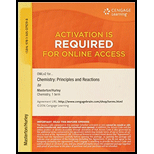
Concept explainers
(a)
Interpretation:
The formula of the coordination compound formed by Cu+ with NH3 needs to be determined.
Concept introduction:
Coordination compounds are those in which a transition metal atom is bonded to a ligand which can be neutral, cationic or anionic. The
(b)
Interpretation:
The formula of the coordination compound formed by Pt2+ with oxalate ion needs to be determined.
Concept introduction:
Coordination compounds are those in which a transition metal atom is bonded to a ligand which can be neutral, cationic or anionic. The transition metal element is enclosed within a bracket and a charge is present on the ion to balance the charge present on the ligands. The total charge present on any complex ion is equal to the sum of the oxidation number of the central metal atom and the total charges of the ligand present in it.
(c)
Interpretation:
The formula of the coordination compound formed by Cd2+ with H2 O needs to be determined.
Concept introduction:
Coordination compounds are those in which a transition metal atom is bonded to a ligand which can be neutral, cationic or anionic. The transition metal element is enclosed within a bracket and a charge is present on the ion to balance the charge present on the ligands. The total charge present on any complex ion is equal to the sum of the oxidation number of the central metal atom and the total charges of the ligand present in it.
(d)
Interpretation:
The formula of the coordination compound formed by Fe3+ with cyanide ions needs to be determined.
Concept introduction:
Coordination compounds are those in which a transition metal atom is bonded to a ligand which can be neutral, cationic or anionic. The transition metal element is enclosed within a bracket and a charge is present on the ion to balance the charge present on the ligands. The total charge present on any complex ion is equal to the sum of the oxidation number of the central metal atom and the total charges of the ligand present in it.
Want to see the full answer?
Check out a sample textbook solution
Chapter 19 Solutions
CHEMISTRY:PRIN.+REACTIONS-OWLV2 ACCESS
- Please help me Please use https://app.molview.com/ to draw this. I tried, but I couldn't figure out how to do it.arrow_forwardPropose a synthesis of 1-butanamine from the following: (a) a chloroalkane of three carbons (b) a chloroalkane of four carbonsarrow_forwardSelect the stronger base from each pair of compounds. (a) H₂CNH₂ or EtzN (b) CI or NH2 NH2 (c) .Q or EtzN (d) or (e) N or (f) H or Harrow_forward
- 4. Provide a clear arrow-pushing mechanism for each of the following reactions. Do not skip proton transfers, do not combine steps, and make sure your arrows are clear enough to be interpreted without ambiguity. a. 2. 1. LDA 3. H3O+ HOarrow_forwardb. H3C CH3 H3O+ ✓ H OHarrow_forward2. Provide reagents/conditions to accomplish the following syntheses. More than one step is required in some cases. a. CH3arrow_forward
- Identify and provide an explanation that distinguishes a qualitative and quantitative chemical analysis. Provide examples.arrow_forwardIdentify and provide an explanation of the operational principles behind a Atomic Absorption Spectrometer (AAS). List the steps involved.arrow_forwardInstructions: Complete the questions in the space provided. Show all your work 1. You are trying to determine the rate law expression for a reaction that you are completing at 25°C. You measure the initial reaction rate and the starting concentrations of the reactions for 4 trials. BrO³¯ (aq) + 5Br¯ (aq) + 6H* (aq) → 3Br₂ (l) + 3H2O (l) Initial rate Trial [BrO3] [H*] [Br] (mol/L) (mol/L) | (mol/L) (mol/L.s) 1 0.10 0.10 0.10 8.0 2 0.20 0.10 0.10 16 3 0.10 0.20 0.10 16 4 0.10 0.10 0.20 32 a. Based on the above data what is the rate law expression? b. Solve for the value of k (make sure to include proper units) 2. The proposed reaction mechanism is as follows: i. ii. BrО¸¯ (aq) + H+ (aq) → HBrO3 (aq) HBrO³ (aq) + H* (aq) → H₂BrO3* (aq) iii. H₂BrO³* (aq) + Br¯ (aq) → Br₂O₂ (aq) + H2O (l) [Fast] [Medium] [Slow] iv. Br₂O₂ (aq) + 4H*(aq) + 4Br(aq) → 3Br₂ (l) + H2O (l) [Fast] Evaluate the validity of this proposed reaction. Justify your answer.arrow_forward
 Chemistry: Principles and ReactionsChemistryISBN:9781305079373Author:William L. Masterton, Cecile N. HurleyPublisher:Cengage Learning
Chemistry: Principles and ReactionsChemistryISBN:9781305079373Author:William L. Masterton, Cecile N. HurleyPublisher:Cengage Learning Chemistry: The Molecular ScienceChemistryISBN:9781285199047Author:John W. Moore, Conrad L. StanitskiPublisher:Cengage Learning
Chemistry: The Molecular ScienceChemistryISBN:9781285199047Author:John W. Moore, Conrad L. StanitskiPublisher:Cengage Learning Chemistry & Chemical ReactivityChemistryISBN:9781337399074Author:John C. Kotz, Paul M. Treichel, John Townsend, David TreichelPublisher:Cengage Learning
Chemistry & Chemical ReactivityChemistryISBN:9781337399074Author:John C. Kotz, Paul M. Treichel, John Townsend, David TreichelPublisher:Cengage Learning ChemistryChemistryISBN:9781305957404Author:Steven S. Zumdahl, Susan A. Zumdahl, Donald J. DeCostePublisher:Cengage Learning
ChemistryChemistryISBN:9781305957404Author:Steven S. Zumdahl, Susan A. Zumdahl, Donald J. DeCostePublisher:Cengage Learning Chemistry: An Atoms First ApproachChemistryISBN:9781305079243Author:Steven S. Zumdahl, Susan A. ZumdahlPublisher:Cengage Learning
Chemistry: An Atoms First ApproachChemistryISBN:9781305079243Author:Steven S. Zumdahl, Susan A. ZumdahlPublisher:Cengage Learning





